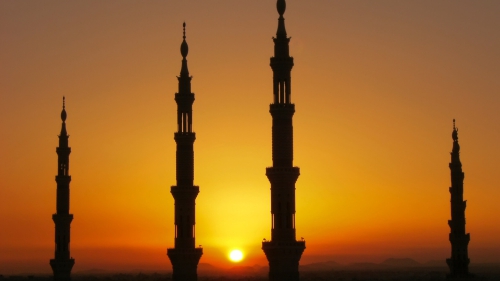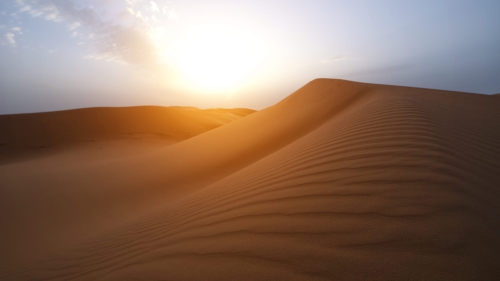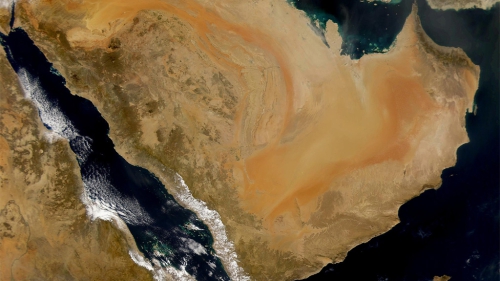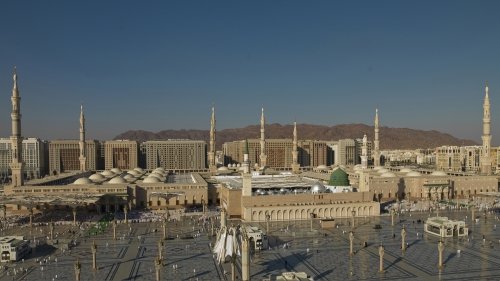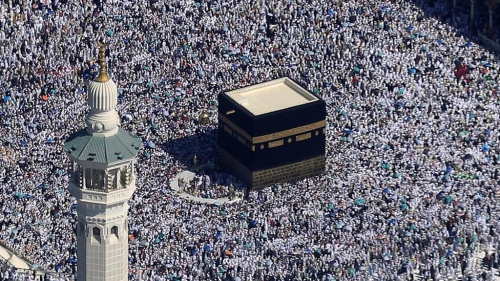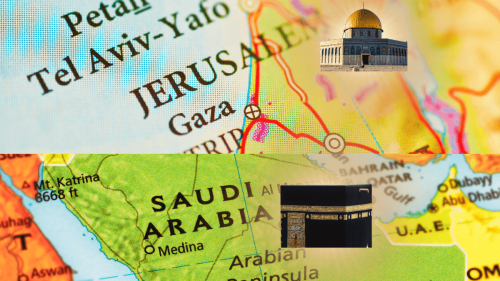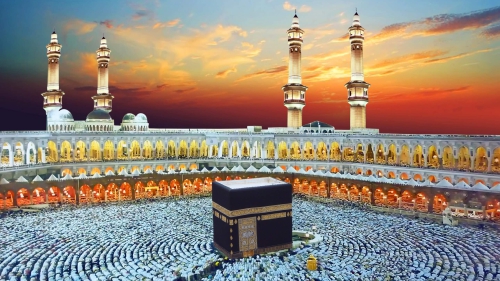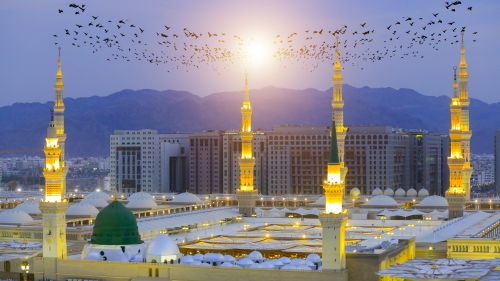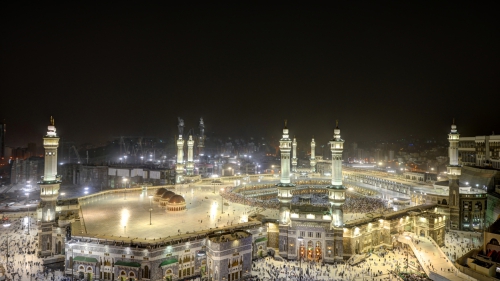The Hijrah

After Muhammad had preached publicly for more than a decade, the opposition to him reached such a high pitch that, fearful for their safety, he sent some of his adherents to Ethiopia, where the Christian ruler extended protection to them, the memory of which has been cherished by Muslims ever since.
But in Mecca the persecution worsened. Muhammad's followers were harassed, abused, and even tortured. At last, therefore, Muhammad sent seventy of his followers off to the northern town of Yathrib, which was later to be renamed Medina ("The City"). Later, in the early fall of 622, he learned of a plot to murder him and, with his closest friend, Abu Bakr al-Siddiq, set off to join the emigrants.
In Mecca the plotters arrived at Muhammad's home to find that his cousin, 'Ali, had taken his place in bed. Enraged, the Meccans set a price on Muhammad's head and set off in pursuit. Muhammad and Abu Bakr, however, had taken refuge in a cave where, as they hid from their pursuers, a spider spun its web across the cave's mouth. When they saw that the web was unbroken, the Meccans passed by and Muhammad and Abu Bakr went on to Medina, where they were joyously welcomed by a throng of Medinans as well as the Meccans who had gone ahead to prepare the way.
This was the Hijrah - anglicized as Hegira - usually, but inaccurately, translated as "Flight" - from which the Muslim era is dated. In fact, the Hijrah was not a flight but a carefully planned migration which marks not only a break in history - the beginning of the Islamic era- but also, for Muhammad and the Muslims, a new way of life. Henceforth, the organizational principle of the community was not to be mere blood kinship, but the greater brotherhood of all Muslims. The men who accompanied Muhammad on the Hijrah were called the Muhajirun - "those that made the Hijrah" or the "Emigrants" - while those in Medina who became Muslims were called the Ansar or "Helpers."
Muhammad was well acquainted with the situation in Medina. Earlier, before the Hijrah, the city had sent envoys to Mecca asking Muhammad to mediate a dispute between two powerful tribes. What the envoys saw and heard had impressed them and they had invited Muhammad to settle in Medina. After the Hijrah, Muhammad's exceptional qualities so impressed the Medinans that the rival tribes and their allies temporarily closed ranks as, on March 15, 624, Muhammad and his supporters moved against the pagans of Mecca.
 Photo: A colonnade of lofty arches surrounds the courtyard at the Prophet's Mosque in Medina, after Mecca the second holiest city of Islam.
Photo: A colonnade of lofty arches surrounds the courtyard at the Prophet's Mosque in Medina, after Mecca the second holiest city of Islam.
The first battle, which took place near Badr, now a small town southwest of Medina, had several important effects. In the first place, the Muslim forces, outnumbered three to one, routed the Meccans. Secondly, the discipline displayed by the Muslims brought home to the Meccans, perhaps for the first time, the abilities of the man they had driven from their city. Thirdly, one of the allied tribes which had pledged support to the Muslims in the Battle of Badr, but had then proved lukewarm when the fighting started, was expelled from Medina one month after the battle. Those who claimed to be allies of the Muslims, but tacitly opposed them, were thus served warning: membership in the community imposed the obligation of total support.
A year later the Meccans struck back. Assembling an army of three thousand men, they met the Muslims at Uhud, a ridge outside Medina. After an initial success the Muslims were driven back and the Prophet himself was wounded. As the Muslims were not completely defeated, the Meccans, with an army of ten thousand, attacked Medina again two years later but with quite different results. At the Battle of the Trench, also known as the Battle of the Confederates, the Muslims scored a signal victory by introducing a new defense. On the side of Medina from which attack was expected they dug a trench too deep for the Meccan cavalry to clear without exposing itself to the archers posted behind earthworks on the Medina side. After an inconclusive siege, the Meccans were forced to retire. Thereafter Medina was entirely in the hands of the Muslims.
The Constitution of Medina - under which the clans accepting Muhammad as the Prophet of God formed an alliance, or federation - dates from this period. It showed that the political consciousness of the Muslim community had reached an important point; its members defined themselves as a community separate from all others. The Constitution also defined the role of non-Muslims in the community. Jews, for example, were part of the community; they were dhimmis, that is, protected people, as long as they conformed to its laws. This established a precedent for the treatment of subject peoples during the later conquests. Christians and Jews, upon payment of a yearly tax, were allowed religious freedom and, while maintaining their status as non-Muslims, were associate members of the Muslim state. This status did not apply to polytheists, who could not be tolerated within a community that worshipped the One God.
 Photo: The Ka'bah, spiritual axis of the Muslim world, stands in the courtyard of Mecca's Sacred Mosque.
Photo: The Ka'bah, spiritual axis of the Muslim world, stands in the courtyard of Mecca's Sacred Mosque.
Ibn Ishaq, one of the earliest biographers of the Prophet, says it was at about this time that Muhammad sent letters to the rulers of the earth - the King of Persia, the Emperor of Byzantium, the Negus of Abyssinia, and the Governor of Egypt among others - inviting them to submit to Islam. Nothing more fully illustrates the confidence of the small community, as its military power, despite the battle of the Trench, was still negligible. But its confidence was not misplaced. Muhammad so effectively built up a series of alliances among the tribes his early years with the Bedouins must have stood him in good stead here- that by 628 he and fifteen hundred followers were able to demand access to the Ka'bah during negotiations with the Meccans. This was a milestone in the history of the Muslims. Just a short time before, Muhammad had to leave the city of his birth in fear of his life. Now he was being treated by his former enemies as a leader in his own right. A year later, in 629, he reentered and, in effect, conquered Mecca without bloodshed and in a spirit of tolerance which established an ideal for future conquests. He also destroyed the idols in the Ka'bah, to put an end forever to pagan practices there. At the same time Muhammad won the allegiance of 'Amr ibn al-'As, the future conqueror of Egypt, and Khalid ibn al-Walid, the future "Sword of God," both of whom embraced Islam and joined Muhammad. Their conversion was especially noteworthy because these men had been among Muhammad's bitterest opponents only a short time before.
In one sense Muhammad's return to Mecca was the climax of his mission. In 632, just three years later, he was suddenly taken ill and on June 8 of that year, with his third wife 'Aishah in attendance, the Messenger of God "died with the heat of noon."
 Photo: Devout Muslims from all over the world gather for the pilgrimage to Mecca, for nearly fourteen centuries one of the most impressive religious gatherings in the world.
Photo: Devout Muslims from all over the world gather for the pilgrimage to Mecca, for nearly fourteen centuries one of the most impressive religious gatherings in the world.
The death of Muhammad was a profound loss. To his followers this simple man from Mecca was far more than a beloved friend, far more than a gifted administrator, far more than the revered leader who had forged a new state from clusters of warring tribes. Muhammad was also the exemplar of the teachings he had brought them from God: the teachings of the Quran, which, for centuries, have guided the thought and action, the faith and conduct, of innumerable men and women, and which ushered in a distinctive era in the history of mankind. His death, nevertheless, had little effect on the dynamic society he had created in Arabia, and no effect at all on his central mission: to transmit the Quran to the world. As Abu Bakr put it: "Whoever worshipped Muhammad, let him know that Muhammad is dead, but whoever worshipped God, let him know that God lives and dies not."
Topics: Hijrah (Migration), Madinah (Medina), Makkah (Mecca)
Views: 10049
Related Suggestions






